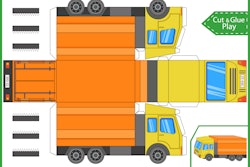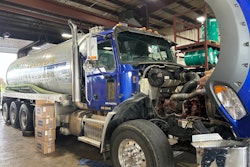
CEO and co-founder of IoT company Samsara Sanjit Biswas compared the transition to electric vehicles to the smartphone transition when consumers slowly but surely migrated from Nokia “candy bar phones” that would last a week without needing to be charged to the iPhone that had to be plugged in every night.
It's a learning curve, he said.
“I think something similar is happening with EVs, which is many of our customers are now starting to see that it's cheaper, practically speaking, to run a work truck that's electric because you're not doing oil changes, the brakes last a little bit longer, the drivers have a better experience (because) it's quieter. There are lots of other benefits to this in addition to the sustainability benefits,” Biswas said. “But the challenge is working through the practical pieces, and the best way to do it is to just get started. Take on projects; focus on it, and then use tools, use data, to make that transition happen.”
That was the overarching theme during Samsara’s recent sustainability roundtable webinar: just get started. Webinar panelists said despite the many hurdles to overcome, like charging infrastructure and raising the capital to invest, the industry has to learn by doing; you make the most progress through your failure.
“In the first couple of months that we started this Class 8 journey, we learned so much more than we were able to learn from a book, so to speak, from reading research reports and talking to people,” said Stephan Schablinski, vice president of operations excellence for Go Green at DHL. “By really doing it, we have made tremendous experience and learnings. Not all of them were like ‘Hooray, we made it.’ Some of them were, ‘Oh my God! What happened here’ or ‘Why have we not thought about this.’ But I think this is so important to go through and make the real-world learning to really figure out how can we make this better.”
Schablinski, who leads the North American Go Green strategic initiative, said DHL has invested about €180 million into electrification, taking roughly 30,000 of 120,000 road vehicles electric. The company wants to take 60% of its last-mile delivery vehicles electric by 2030 and have 60% of its heavy goods vehicles on sustainable fuels by 2030 in an effort to reduce its Scope 1 and 2 emissions by 42% and its Scope 3 emissions by 25%. The goal is zero by 2050.
Starting small
This is where companies like Samsara are stepping in to help fleets determine which vehicles can be transitioned to EVs or alternative fuels. The company is also helping fleets find other ways – like route optimization, for example – to reach sustainability goals in the meantime while those technologies continue to develop.
Those technologies aren’t widely available just yet for the heavy-duty sector, but light duty, like work vans, is well underway and a good place to start transitioning a fleet, Biswas said.
“This is planetary scale infrastructure. It has to be practical, it has to make financial sense, but it also has to make just operational sense. Can this be done?” he said. “The good news is there are some amazing tailwinds that are really starting to become apparent this year in 2023. The first is just around the EV market in general. EVs have now been mainstream for almost a decade and we're starting to see manufacturers have vehicle availability finally, especially here in North America, and that's transforming what's possible in the market.”
Electrification is not the only technology that DHL is using to decarbonize operations. Schablinski said DHL is also investing in sustainable fuels like renewable diesel or renewable natural gas.
Those are what Matt McLelland, vice president of sustainability and innovation at Covenant, calls bridge technologies between diesel and EV.
“Americans want things to happen tomorrow,” he said during a panel discussion at the 2023 Trimble Insight Tech Conference and Expo in Las Vegas. “We don’t give bridge technologies like renewable diesel a fair shake.”
Another step, he said, is to simply buy newer diesel trucks.
“If you want to reduce emissions by 50% in California by the end of this year, it can be done,” he said. “Ninety-plus percent of fleets in California are small; the small companies need to go buy new trucks. Their trucks are so old, the emissions are high.”
Shifting gears from light duty to heavy duty
The panelists agreed that bridge technologies like alternative fuels will lead the way for the heavy-duty sector for years to come, but there are some use cases for EV there already like yard trucks, which don’t travel long range and are always near a facility where they can charge.
Schablinski said DHL is no longer purchasing diesel yard trucks.
“We learned how to swim in a pool by using this yard truck, and now we have the confidence … Now we go to the ocean and try to apply the same kind of learning to the on-the-road Class 8 trucks,” he said.
That’s the next step toward zero emissions – implementing electric across the heavy-duty sector, but that means talking to property owners, facility owners and EV charging service providers to create the charging infrastructure needed to adopt EV trucks on a mass scale. It also includes the ecosystem of third-party vendors that can provides services like maintenance.
Biswas said it doesn’t make sense for fleets to buy EV trucks until those things are in place. In the meantime, Samsara is using telematics data to inform its customers on which equipment can be transitioned to EV.
Unfortunately, many smaller fleets, especially owner operators, haven’t even stepped into telematics technology yet, much less the transition to EV or alt fuels.
Mike Thompson, senior partner leading the sustainability and logistics practice at consulting firm McKinsey, said there’s still a big question mark over how the industry will get small operations, which make up the majority of fleets in the U.S, on board. That could look like government incentives or shippers and brokers paying more, he said, but it could also cause a seismic shift in the demographics of the industry.
“If there's a lot of pressure to move to (EV) by 2035, it could lead to consolidation where really only the big players have the funds to play in that space,” Thompson said.
But before fleets can make the transition, they have to measure before they can manage.
Covenant began by taking inventory of its own company’s emissions to put together its first CSR (corporate social responsibility) report, McLelland said.
“Read CSR reports from your favorite competitors, then you can pivot to ESG, Scope 1, 2, 3, etc.,” he said. “If you haven’t done a report, you should; it pushes the leadership team to determine how far they’re willing to go.”














